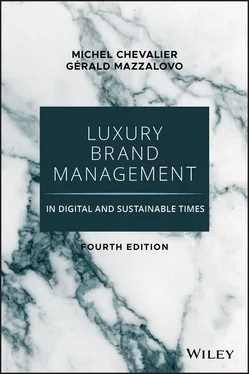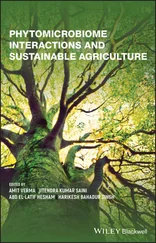We find also a correspondence between the notion of product vaporization and the concept of aura introduced by Walter Benjamin, which he defines as being what makes an art piece authentic and unique, that is, “the unique phenomenon of a distance, however close it may be.” 26We may extrapolate that some consumption objects are so exceptional that they can generate emotional shocks, and that they can qualify as having a genuine aura (an engagement ring, a vintage collection car, a famous precious stone), a sort of halo, which transfigurates them, makes them distant, apparently unapproachable—although proximate because they are accessible through purchase. This could be a definition of luxury, where the power of an object reaches beyond its functional purpose and forces the customer into a different world, due to the apparent inaccessibility, exceptionality, intensity, and, sometimes, strangeness of the product.
Exclusive versus Exceptional Luxuries
Rather than being constant and predictable, as we highlighted at the beginning of the chapter, the evolution of the connotation of the word luxury and its related perception of the phenomenon continues these days. As shown in Figure 1.7, the perception of luxury and its associated values changes according to the cultural and historical contexts.
This confirms Michaud's vaporization trend, where experience is proving to be the biggest expansion of the new luxury today. The figure highlights the fact that some of the values, such as hedonism, preciousness, memory, and sophistication, of the traditional luxury remain shared with the new one. Besides the two dichotomies, product/experience and exclusivity/exceptional, the main divide is related to the social/individual dialectic. The ostentatious nature and the sense of belonging to a restricted and exclusive group that is characteristic of the traditional luxury are essentially of a social nature, whereas new luxury is much more attached to a personal feeling where the social dimension is nonessential—even though the craze of selfies proves that when people experience something exceptional, they rush to share it on the Internet.

Figure 1.7 Evolution from Traditional to New Luxury

Figure 1.8 Semiotic Square on Different Types of Luxury
Within the process of analysis of Jim Thompson's brand identity in late 2015, we asked Professor Jorge Lozano (chair of theory of information at Complutense University in Madrid) to reflect on the reality and meaning of the emerging expression new luxury . The result of his reflection is a semiotic square ( Figure 1.8) built on the semantic axis of exclusivity versus exceptionality that was published later in 2018. 27
The notion of exclusivity implies the other qualities mentioned earlier, such as being rare, expensive, and inaccessible. The most meaningful dimension in which the notion of exceptionality can be opposed to exclusivity (and therefore considered as a contrary) lies in the fact that the latter is of the private, individual, and subjective sphere, whereas the former is in the social and public domain. Building the semiotic square by formalizing the contradictories to exclusive and exceptional, we come up with a scheme that classifies most of the luxury categories we have mentioned so far:
Traditional luxury will combine both exclusive and exceptional. A vintage Jaguar type E could be an example.
The opposite position that combines nonexclusivity and nonexceptionality is mass luxury (an obvious oxymoron), which applies to all the brand products that are trying to trigger a luxury perception while being chain-manufactured. Marc by Marc Jacobs or Ibis hotels are relevant examples of this positioning.
The side of the square combining exclusivity and nonexceptionality is the premium segment, or intermediate luxury. We will find there most of the wines and spirits brands, Svarowski, and Audi.
Finally, the side of exceptional and nonexclusive defines new luxury, where accessibility becomes the main differentiating element with respect to traditional luxury.
In line with the notion of exceptionality that has been introduced, we could risk a new definition of luxury that would reflect this characteristic as well as moralize somewhat this type of consumption. Is luxury an exceptional co-investment from both parties concerned—the brand and the consumer?
Products, services, experiences can be qualified as being of luxury nature, when both the brand and the customer have invested their resources beyond the norm(s) in the respective processes of proposing and acquiring them.
The customer investment goes beyond the acquisition price, it may involve a long research, a long study, sacrifices, and so on.
To conclude this section on new luxury, we quote Jorge Lozano, referred to earlier:
Today, in the realm of Generalized Simulation, under the rules of big data, where the future becomes irrelevant and presentism reigns as the major tendency, emerges the authentic, which although it cannot replace the unique, the uniqueness, fundamental characteristic of the exclusive, it serves as a consolation. For its part, the exceptional of the original and genuine, of what possesses aura and belongs to the core of luxury, currently adopts other pregnant manifestations of subjectivity, expressed in cyberspace, configured with new materials. That new exceptionality can live perfectly with the non-exclusive, promoting what I consider to be the new luxury. 28
Conclusion on the Notion of Luxury
Several lessons can be drawn from this very general overview of the different dimensions of luxury.
Luxury became first an elitist and rewarding practice and then, under the impulse of brands, a market that is submitted to an ever-increasing segmentation. Today, there is not one luxury but many of them, each aimed at a specific category of population, characterized by their purchasing power, social group codes, and specific ambitions. We must get used to an acceptance of the term much broader than in the past. It has now become necessary to clarify, each time, what sort of luxury we want to talk about.
Despite their many manifestations, luxuries provide some common benefits. Luxury divides and unites at the same time; it produces distinction under the banner of brands; it blurs (with the exception of very exclusive luxury) the line between discomfort and opulence, but it promises to all social layers to escape the mass by consuming better (in the case of true luxury) or just a little better (in the case of intermediate luxury) than our peers. Luxury re-creates tribes, groups of the happy few being in the sharing of practical or symbolic qualities. This may be the excellence of a product, originality, the newness of a style, or, more informally, the manifestation of a certain state of mind. Luxury should both make us dream (logic of desire) and comfort us by communicating sensual or emotional satisfactions (logic of pleasure).
Luxury works in opposition to a norm, to a convention shared by the greatest number—the “vulgar,” in the etymological sense of the term. In this sense, the lapidary definition of Coco Chanel perfectly expresses its essence: “Luxury is the opposite of vulgarity.”
The challenge for luxury brands is going to be defining what kind of convention it wants to be distinguished from and by which means it will show its differences. From there follows its positioning and its strategy. Authentic and discreet luxury follows the saying that “money does not matter.” It is from the mercantile norms that it intends to deviate. Economic issues are occulted in favor of the affirmation of perennial values. Its eccentricity will be modeled on the axes of aesthetic research, qualitative perfection, rejection of the ephemeral, in short, of an investment of exception. For intermediate luxury, the norms it dissociates from are those of a degraded version of daily life—the ordinary—from which it promises to escape in a fugitive whiff of distinction and fantasy, as in role playing.
Читать дальше














